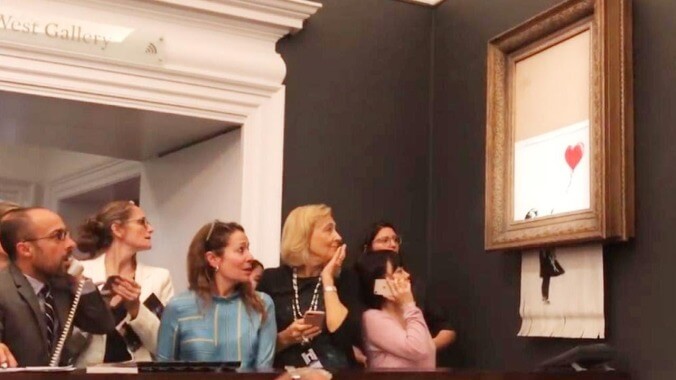History remembers these people, just not their names

This week’s entry: Unidentified people
What it’s about: Nobody knows! Or, more accurately, nobody knows who it’s all about. Throughout history, people have made a name for themselves without anyone actually knowing their name, from the protestor who stood up to a tank in Tiananmen Square in 1989, to notorious successful hijacker D.B. Cooper (almost certainly not his real name).
Biggest controversy: Jesus neither kicked ass nor took names. The Bible has loads of significant-but-unnamed figures, from the Disciple Whom Jesus Loved, to the Queen of Sheba, to the Concubine of a Levite from the book of Judgement. In fact, Wikipedia has a whole separate page for the biblical nameless, including such notables as Noah’s wife, Ham’s wife, Lot’s wife, Job’s wives, and Pontius Pilate’s wife. (Like Hollywood today, the Bible was a straight white boys’ club.)
Strangest fact: The only straight dope you won’t get from “The Straight Dope” is the identity of the author. The syndicated newspaper column, which ran from 1973 to 2018 was attributed to Cecil Adams, but The Chicago Reader’s copyright filing for the column in 1986 attested the name “does not identify any particular individual but was devised as a fanciful name.” The mystery falls apart pretty quickly, however, when Wikipedia names Ed Zotti as the editor of the column and reveals that he had made public appearances as Adams. Zotti himself has hinted that “Cecil Adams” is a team that researches and writes the column, which he leads.
Thing we were happiest to learn: It’s quite possible to succeed as an artist with a secret identity. Besides the mysterious Banksy, there’s a list of unknown visual artists, including street artist Beast, Italian performance artist Blu, Indian graffiti artists Daku, Guesswho, and Yantr, and Russian sci-fi/fantasy painter Lubov.
Anonymous musicians include outsider musician Y. Bhekhirst, Demon Kakka (who fronts a Japanese metal band and does color commentary for sumo matches), Russian darkwave band Dvar, Japanese kei musicians Hizaki, Közi, Mana, and Teru, Wisconsin punk band Masked Intruder, Silencer singer Nattramn, English multimedia band Patten, rapper Spark Master Tape, Libyan rapper Ibn Thabit, and Canadian black metal band Thantifaxath. The most famous unknowns on the list are surely The Residents, a band that has maintained strict anonymity for 50 years and over 60 albums. (The late Hardy Fox was identified as a member after retiring from the group in 2015.)
Famous literary pen names whose real names remain unknown include Seraphina author Caroline Burney, homeless writer The Cadillac Man, Roy Croft, who pseudonymously wrote the wedding-staple poem “Love,” Italian novelist Elena Ferrante, playwright Jane Martin, and German novelist B. Traven, The Traveler author John Twelve Hawks, manga author Tsugumi Ohba, whose Death Note series has 30 million copies in print.
There have also been unnamed artists throughout history, including 12th-century Hungarian historian Master P (probably not the same person as the rapper), 13th-century English music theorist known only as Anonymous IV, 16th-century Peruvian poets Amarilis and Clarinda, and the unknown author of Gawain And The Green Knight.
Thing we were unhappiest to learn: One of America’s earliest heroes will never get her due. The Culper Ring was George Washington’s spy network during the Revolutionary War, and one of its spies was known only as Agent 355. “355” was Culper code for “lady,” which is the only thing definitely known about 355. It’s speculated that 355 was in fact Anna Strong, a well-known Revolutionary spy, or that she was the common-law wife of Robert Townsend, another Culper spy who never officially married.
355 is believed to have helped expose Benedict Arnold, but was captured when Arnold defected. According to legend, she was held on a prison ship, where she gave birth to Robert Townsend Jr., and died soon after. But there’s no record of a Townsend Jr. ever existing, and women weren’t held on prison ships, so the story is probably a myth.
Best link to elsewhere on Wikipedia: Weirdly, there’s a category for Wikipedia categories named after unidentified people, but it’s only Jack The Ripper, the Zodiac Killer, and the Man In The Iron Mask. More worth a deep dive is the category tombs of unknown soldiers. In 1920, London’s Westminster Abbey buried an unknown combatant in WWI as The Unknown Warrior, making that fallen soldier a symbol for anyone who fell in battle and never received a proper burial, and to some, every soldier who fell in battle, full stop. Britain’s Unknown Warrior was such a powerful symbolic gesture that countries all over the world set up similar memorials.
America’s Tomb Of The Unknown Soldier opened the year after Britain’s, and is guarded by soldiers who take shifts in a ceremonial procession that has continued, unbroken, 24 hours a day, since 1948.
Further down the Wormhole: This is the 277th entry in our 5,821,384-week series, and we’re surprised to come across something we’ve never seen before. A hidden category. The bottom of the page lists Commons: category link is on Wikidata, as a link that presumably wasn’t meant to be seen. The linked page is a list of 201,215 subcategories and 338,216 pages, from Aa (a river in France) to Alexander Zverev (a German tennis player). Which ones made the list and didn’t is completely opaque. But with 539,431 links to choose from, it didn’t take long to find something interesting. Before we even got to the As, we found the story of 5 Pointz, a graffiti-covered factory in New York that led to a legal battle between artists and developers. We’ll take a look next week.